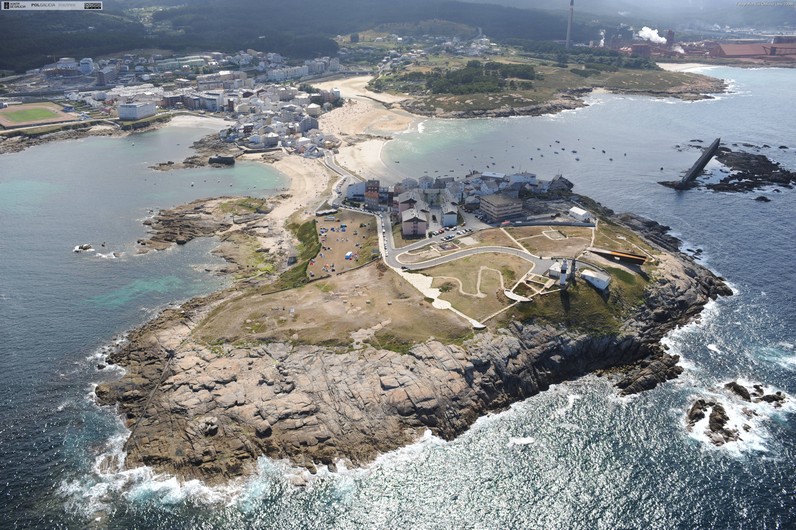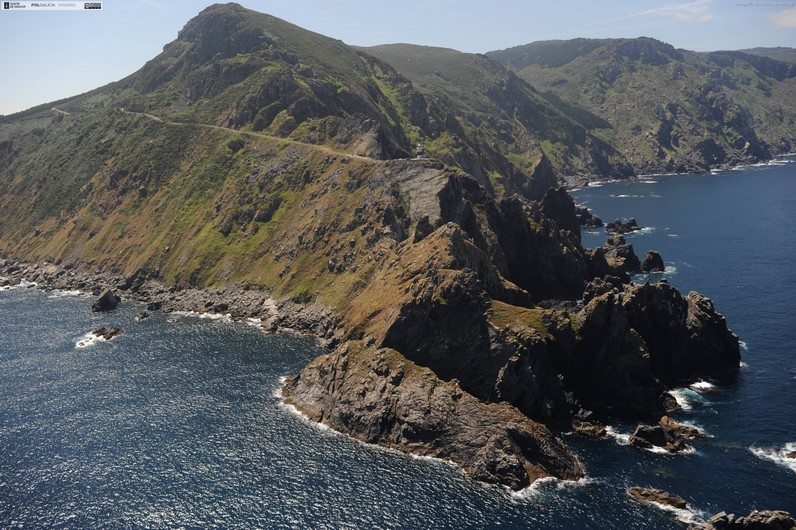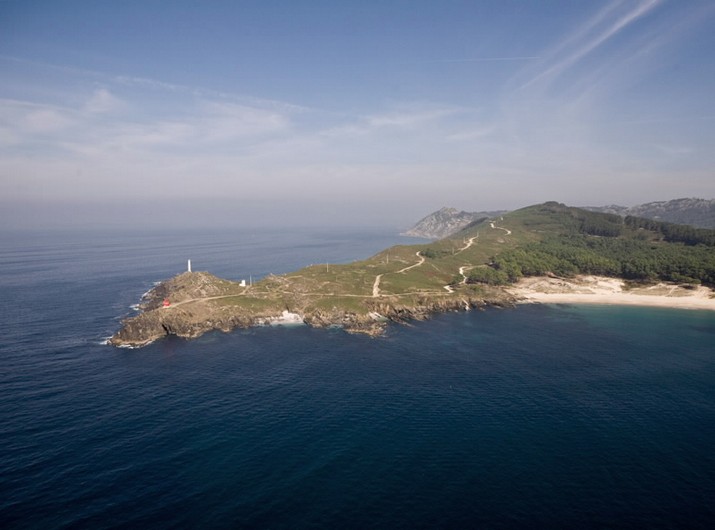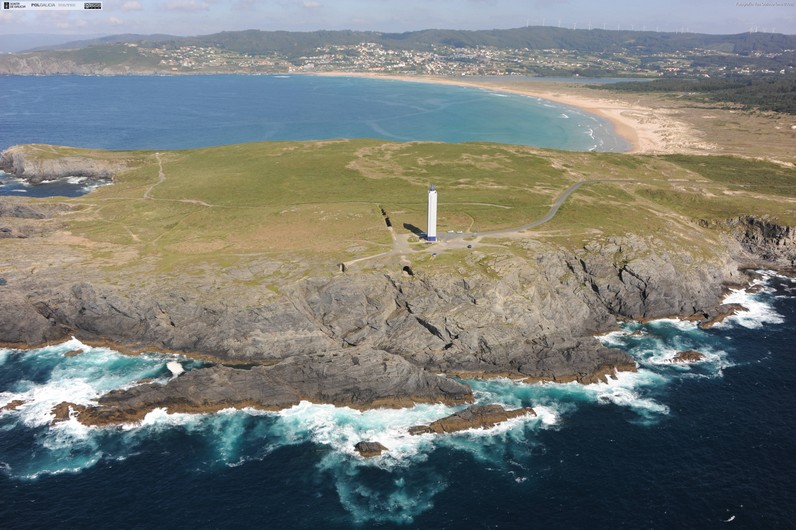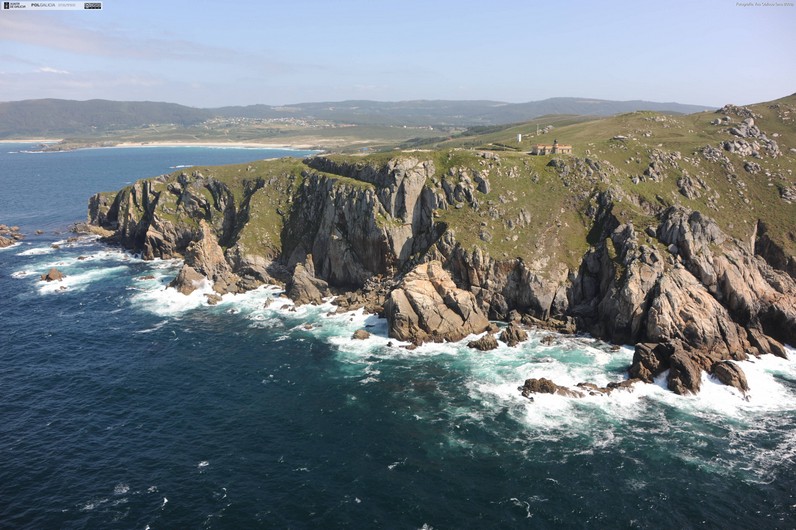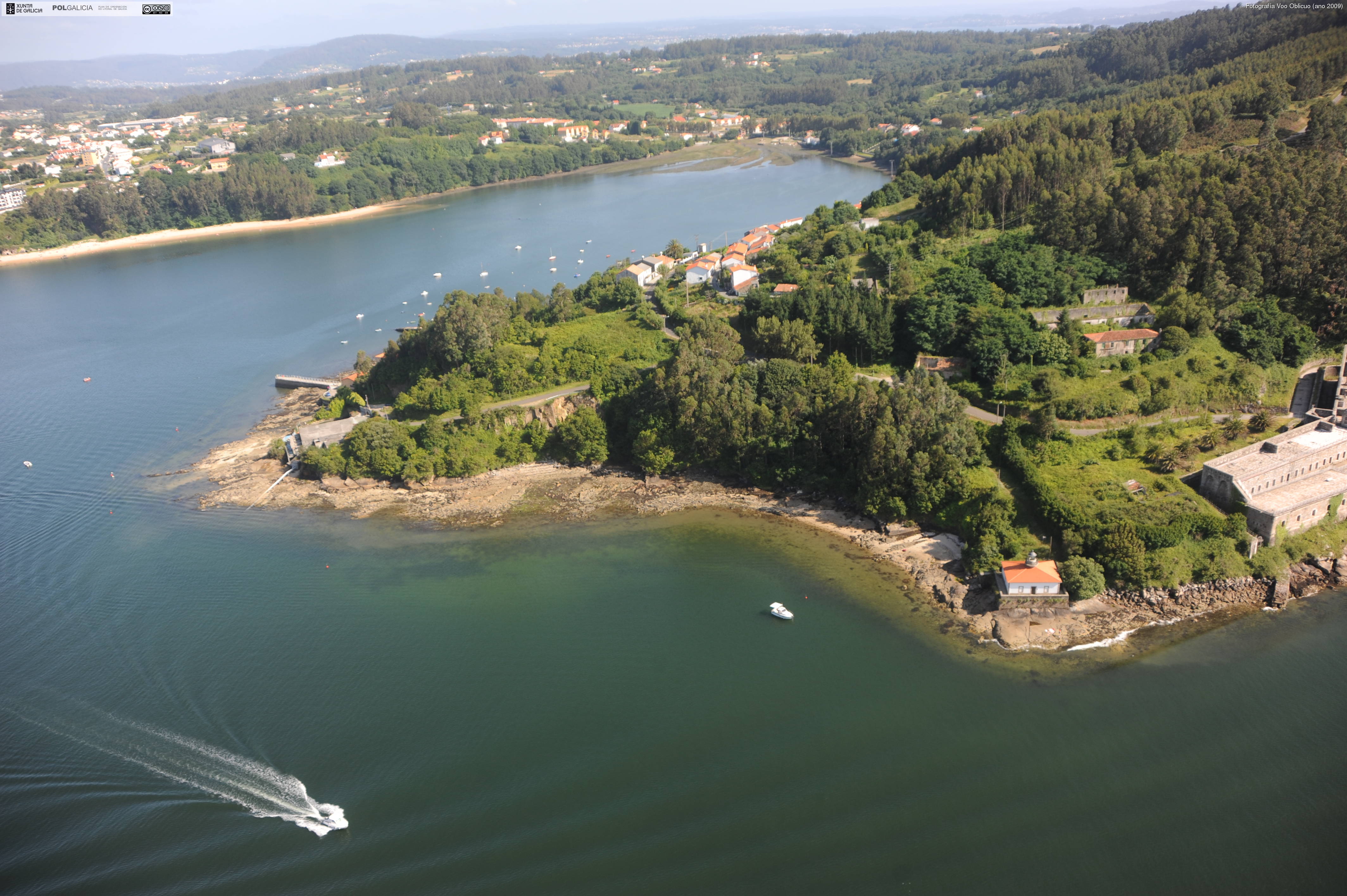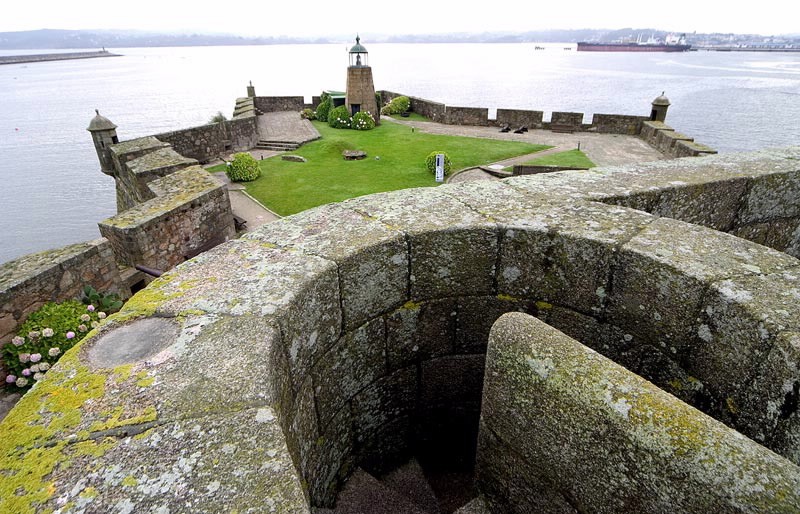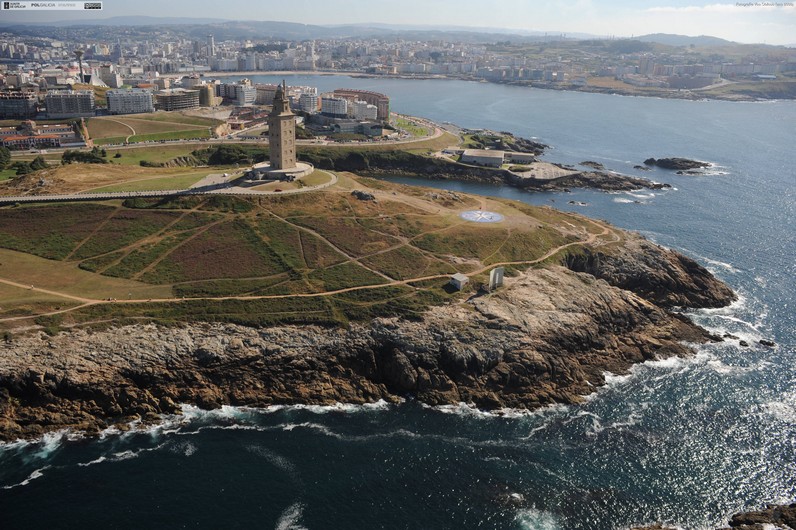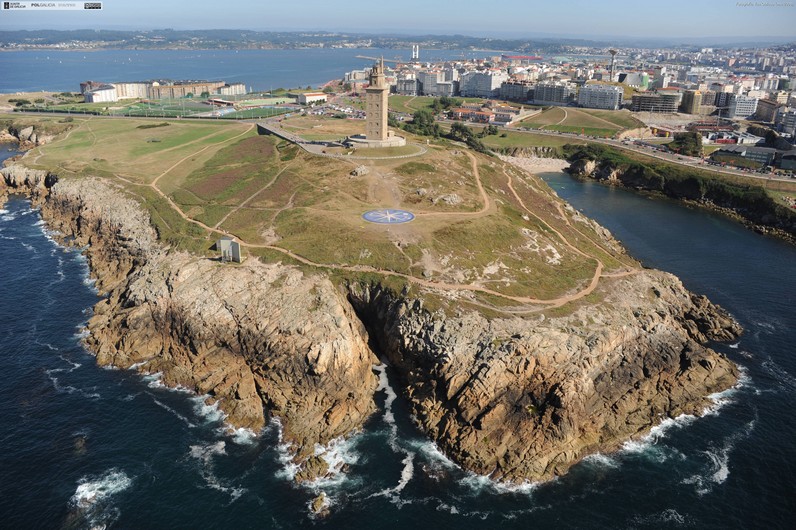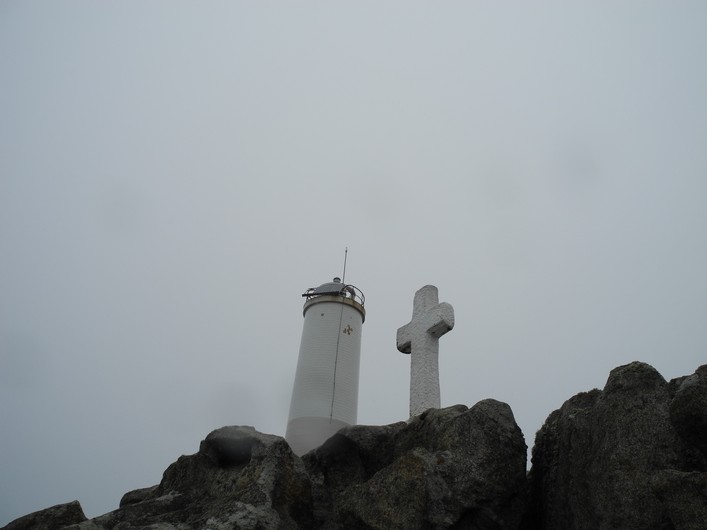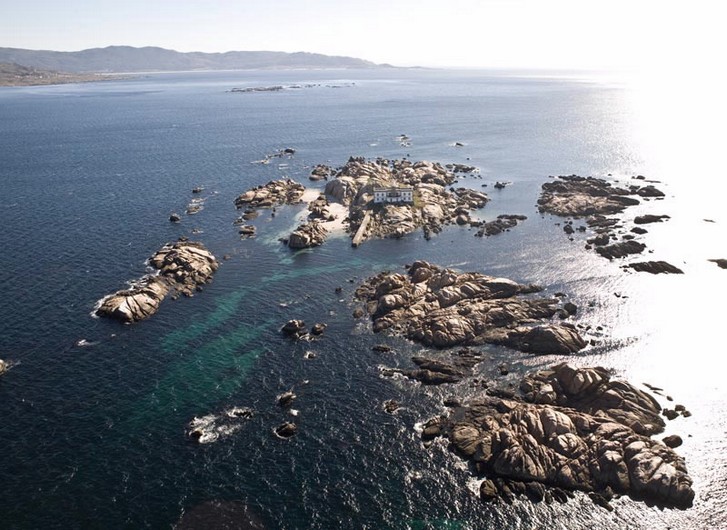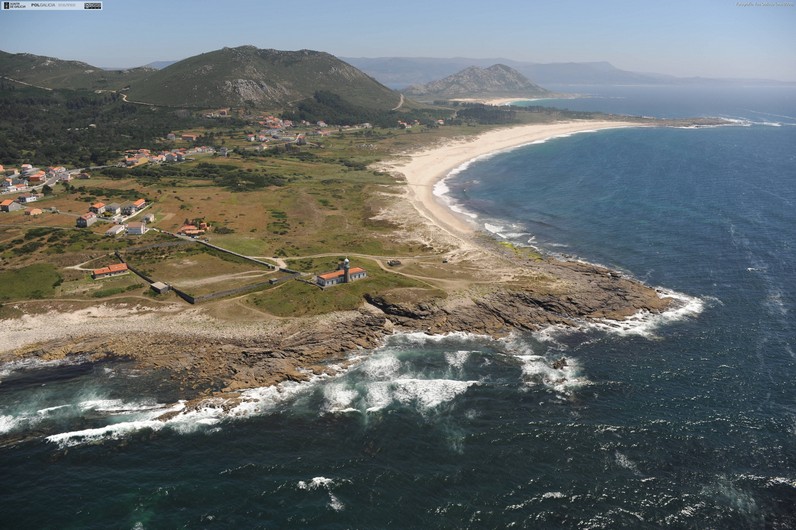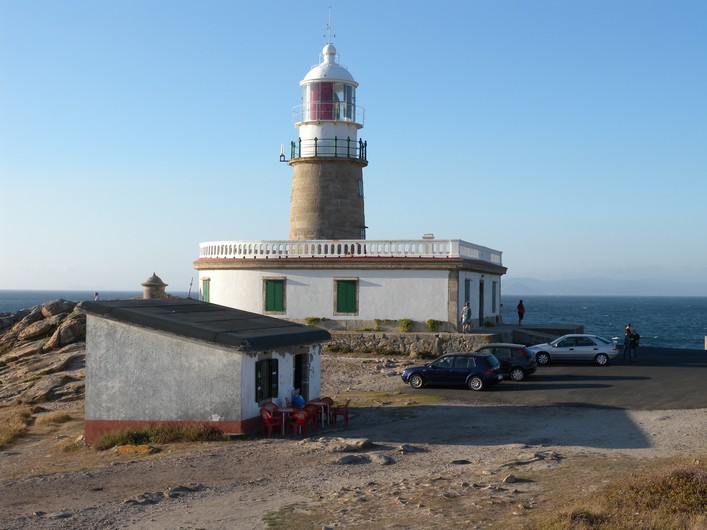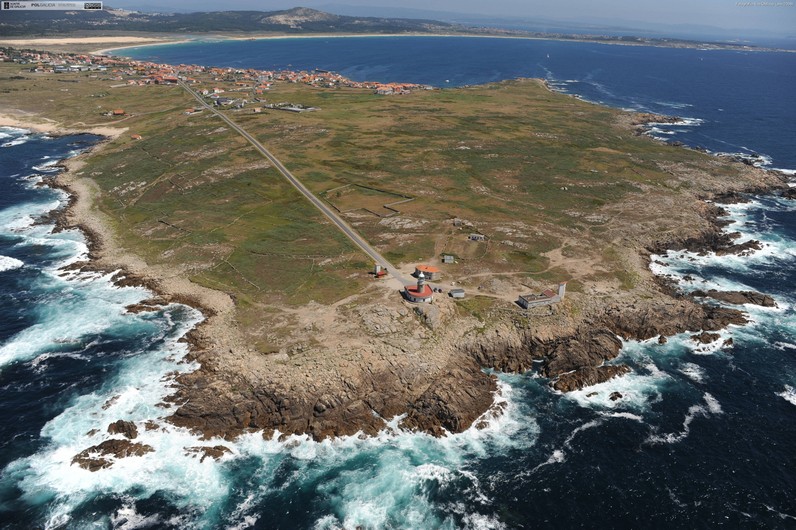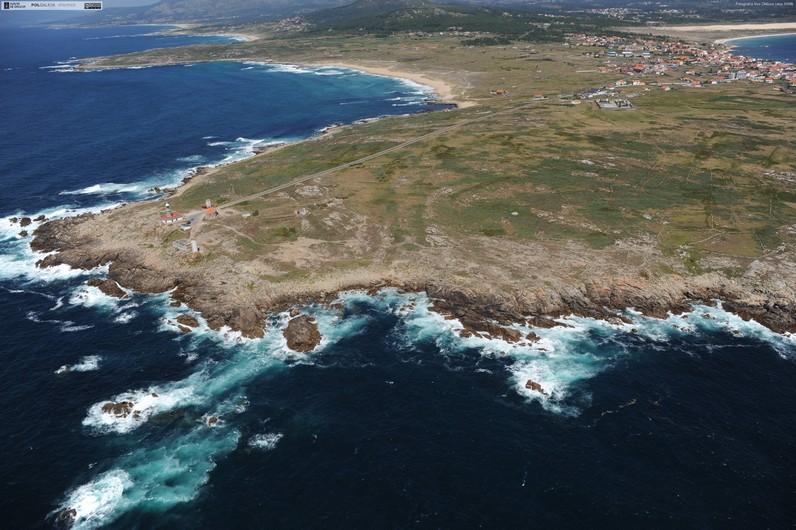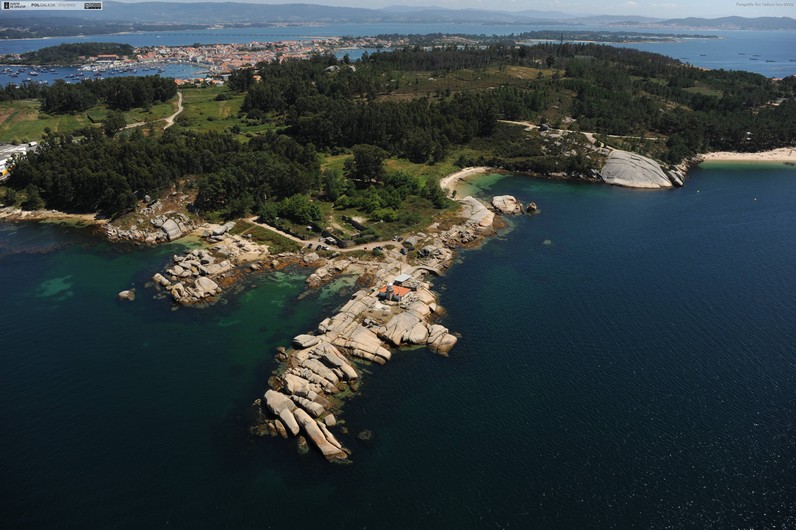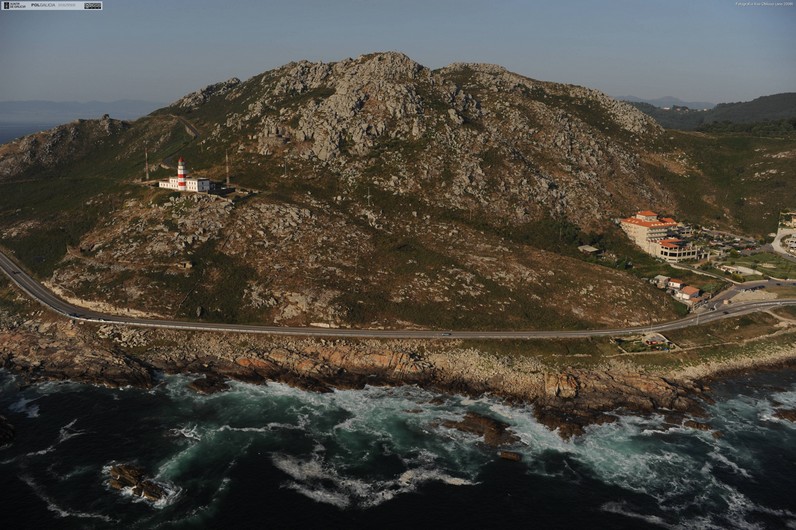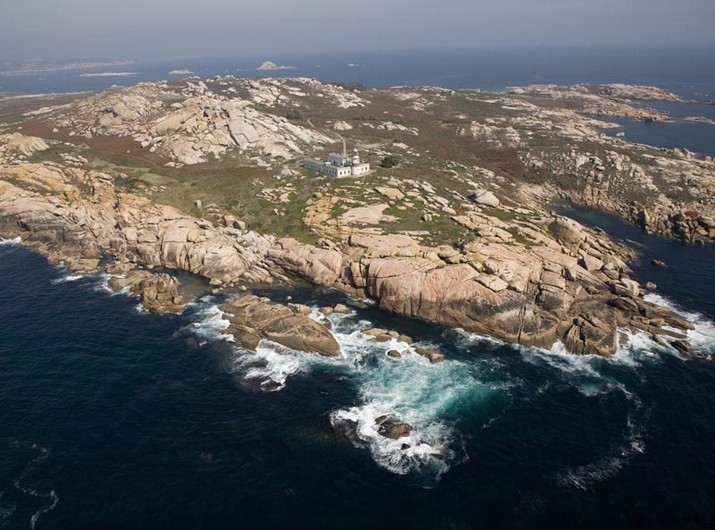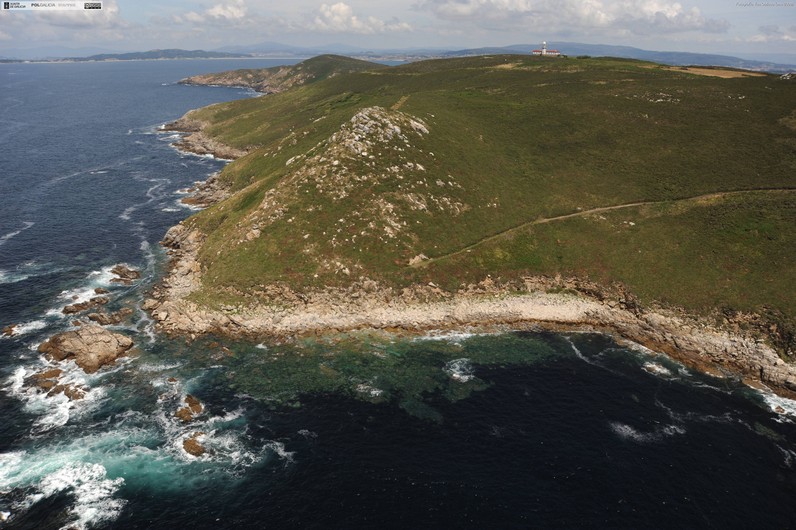- Ribadeo Lighthouse
- San Cibrao Lighthouse
- Punta roncadoira Lighthouse
- Coelleira’s Island Lighthouse
- Estaca de Bares Lighthouse
- Lighthouse of Ortegal Cape
- Punta Candeira Lighthouse
- Punta Robaleira Lighthouse
- Frouxeira Lighthouse
- Prior Cape Lighthouse
- Lighthouse of Prioriño Chico Cape
- Da Palma Lighthouse
- Meda Lighthouse
- Oza’s Lighthouse
- Lighthouse of Castle of San Antón
- Lighthouse of Hércules Tower
- Lighthouse of Sisarga Grande
- Lighthouse of Punta Nariga
- Punta Roncudo Lighthouse
- Laxe Cape Lighthouse
- Lighthouse of Cabo Vilán
- Punta da Barca Lighthouse
- Lighthouse of Touriñán Cape
- Finisterre’s Lighthouse
- Lighthouse of Cee’s Cape
- Lighthouse of Lobeira Grande Island
- Punta Ínsua Lighthouse
- Monte Louro Lighthouse
- Lighthouse Rebordiño Cape
- Corrubedo Lighthouse
- Da Rúa Island Lighthouse
- Punta Cabalo Lighthouse
- Punta da Guía Lighthouse
- Lighthouse of Silleiro
- Lighthouse of Sálvora’s Island
- Ons Island Lighthouse
- Cíes Lighthouse
Ribadeo Lighthouse
Brief history
The agreement of the Lighthouse Commission determined to build a lighthouse in the vicinity of Ribadeo, choosing the island as Pancha so that the entrance of the estuary would illuminate from the west and also would mark the low known Panchorro and Arredo.
This site, and especially the one known as „Torre vella“, located to its height but on land, had served as reference mark to the fishermen and sailors who looked for the entrance to the port of Ribadeo.
The project for the Pancha Island lighthouse was reduced to a fifth-order light with the only signal function for the entrance to the estuary and the Ribadese port. It was probably the first entrusted to the engineer Marcelo Sánchez Movellán and was approved in March of 1857.
In the eighties a new lighthouse was built next to the old one, with the standardized form of cylindrical tower painted with black and white stripes, of concrete of 3 meters of diameter and 12,70 meters of height, that raises the new light to 28 meters over the sea. It entered service in 1983 replacing the old lighthouse, and today it is fully automated.
Curiosities, myths and legends
In the estuary of Ribadeo are the remains of a galleon of the s. XVI discovered in 2011 during one of the periodic dredging that takes place in the estuary to remove sediments from the Eo River and increase the draft of the area.
It is known of the galleon that it was a ship of great tonnage, of 32 meters of length and that agrees with the characteristics of the galleon „Santiago de Galicia“ that sank in 1597 in the Galician estuary and was part of the rest of the Invincible Armada.
It is 4 to 7 meters deep and its value is due to the technical characteristics of its construction since it possessed all the advances of its time, such as the helmet lined with lead to protect the wood and to promote navigability .
In addition, it is a ship similar to the „Mary Rose“, warship Henry VIII of England which is the only warship of the sixteenth century rescued from the sea and can be visited in the port of Portsmouth (England).
San Cibrao Lighthouse
Brief history
The need for a lighthouse was a direct consequence of the rise of one of the most important Galician industries of the s. XIX, the ceramic factories of Sargadelos located in Cervo. It was necessary to drive the mineral fuel and raw materials so we addressed the construction of a road and the modernization of the port. With the increasing traffic became evident the necessity of a lighthouse in the port what was concreted in placing in tip Atalaia of San Cibrao a lighthouse of sixth order.
The project was commissioned in 1861 to Marcelo Sánchez Movellán carrying out a design very similar to that of Pancha Island. On May 30 in 1864 he began to light with a white light oil lamp and 9 miles range. In 1925 Rafael de la Cerda projects a new tower.
The increase in maritime traffic now provoked by the Spanish Alúmina of San Cibrao factory requires an improvement of the conditions of the lighthouse. A new one similar to the one of Pancha Island was constructed with a black upper band and painted white of 13,70 meters of height and 3 meters in diameter. It enters into service the 22 of December of 1983 with a white light that reaches 20 miles.
Curiosities, myths and legends
In 1967 as can be read in the legend of the granite pedestal of the Monument to the Navy in the Beach of O Torno in San Ciprian, Don Manuel Fraga, Minister of Information and Tourism, inaugurated the monument promoted by the fishermen’s guild of the town . History is not without success.
With the living tides of 1965 a World War II war mine entered the San Ciprian estuary until it was stranded on the beach of O Torno. „As the one who does not know is like the one who does not see“, at the exit of the school the children would play with her without suspecting that it was operative.
The authorities of the Navy were informed that after their examination they proceeded to deactivate it and inform the lucky ones that it could have exploded at any moment.
Punta Roncadoira Lighthouse
Brief history
The need to improve the conditions of recognition of the Ria of Viveiro requires the construction of the Roncadoira lighthouse. The difficult entrance to the estuary with an impracticable channel in low tide motivated already in the first half of the twentieth century the installation of two lights emplaced in the ends of its mouth, the mark of Socastro to the west and the one of the tip of Faro to the east.
The project of the lighthouse was authorized the 24 of July of 1974 following the model of cylindrical concrete tower of 3 meters of diameter and 12,70 meters of height and painted of white, entering in service of definitive form the 25 of February of 1984 with A range of 21 miles. In 1993 a new luminous equipment was installed and it was monitored to be supervised from the Control Center of the port of Ferrol.
Curiosities, myths and legends
On the beach of Covas in the Ria of Vivero, stands a monument reminding of the tragedy that occurred on November 2, 1810. A strong storm destroyed the Fragata „Mª Magdalena“ that went to sink on the beach of Covas and dragged the brig Palomo to the Beach of Sacido. Both ships were part of the „Cantabrian Expedition“ and the number of dead reached the figure of 550, one of the greatest tragedies of the Spanish Coast.
This fact had an enormous repercussion at national level, and more if we add the circumstance that the body of the captain Blas de Salcedo of the Fragata „Mª Magdalena“ was found hugged to the one of its son in the beach, reason why the Navy forbade that Parents and children or brothers will embark in the same boat.
Coelleira’s Island Lighthouse
Brief history
After the 1950s, there was a concern to complete the lighting and beaconing of the Galician coastline, signaling all ports and estuaries that could serve as a shelter for boats in the event of a storm. The advanced position of Coelleira with respect to the estuary of Viveiro and O Barqueiro give an ideal location for a minor order lighthouse that facilitates the entrance in both ports once dubbed Estaca de Bares. The project was commissioned to Marcelo Sánchez Movellán in the year 1861 that gave the same construction solution as for the lighthouse of San Cibrao. Before the possibility of isolation in the event of a storm, a cistern was used to collect the rainwater as well as an oven and shed for firewood.
The lighthouse was lit on May 30, 1864 with a range of 9 miles. After several changes in the lighting system in December 1917 is endowed with an acetylene lamp especially indicated for the islands and with a range of 11 miles suppressing the service of the lighthouse keeper. At the present time this electrified, working aided of solar plates with a scope of 8 miles.
Curiosities, stories, myths and legends
Four are the Cantábricas Islands that share cartel for to settle in its ground a monastery dedicated to San Miguel Arcángel: Mount Saint Michael in Normandy (France); Skelling Michael in Ireland; Island of St. Montaje Michael in Cornwall (United Kingdom) and Island Coelleira in Lugo (Galicia).
Coelleira Island is the largest of the Cantabrian Islands of Galicia. In its day was constructed in her a monastery dedicated to San Miguel: San Miguel of Quolicularia. Characterized by the austerity, the monks that inhabited it moved to say mass of Viveiro villaje in boats of leather. Later it is said that the Templars occupied the place. Already uninhabited, today is of ornithological interest because it shelters in her more than 25 different types of birds with more than 15,000 nests census.
Estaca de Bares Lighthouse
Brief history
Historically considered the tip of Estaca de Bares as the northernmost point of the Galician coast and with a relevant role for seamen as it appears in the marine charts and medieval Portulans.
The project of the lighthouse is entrusted to Felix Uhagón who designs a tower of octagonal format that due to the location of the land, located to 93,35 meters on the sea, did not have to develop a great height. The 1 of September of 1850 after several tests begins to operate with a range of 20 miles.
The lighthouse of Bares became a model for other buildings projected on the Galician coast as is the case of Finisterre.
In 1964 it is electrified and in 1993 it is changed again the luminous equipment being monitored to be supervised from the Control Center of the port of Ferrol.
Curiosities, myths and legends
A point where the waters of the Atlantic Ocean and the Cantábrico Sea meet, there are abandoned military installations on the ground. One of them was a US Coast Guard base since the early 1960s.
French and British government stations operated in conjunction with the Estaca de Bares station for LORAN Coast Guard operations. The US Air Force began to control the base from 1978 to 1991. Today they are abandoned.
The LORAN -LOng RAnge Navigation- system is an electronic long range radio navigation system that determines the position based on the interval between the reception of the transmitted signal from three or more points. It was developed during World War II to aid the navigation of allied aviation and North Atlantic convoys.
Lighthouse of Ortegal Cape
Brief history
The tip of Ortegal is surrounded by a dangerous chain of boulders in zone of breakers. Already in the Middle Ages it is reflected in the marine and portulan charts and in the 19th century it will continue to be used as a landing point for transit ships to America and northern Europe, being considered in our days as the imaginary dividing line between the waters of the Bay of Biscay and The Atlantic.
Since 1847 numerous requests have been made to address the construction of the lighthouse that were not serviced until 1982, when the project is commissioned by the engineer Jaime Arrandiaga, becoming one of the most modern lighthouses in Galicia.
The construction takes the standard form of a cylindrical tower of 3 m of diameter and 12,70 m of height painted in two wide strips of colors white and red for its better visibility and with a range of 18 miles.
In 1993 it underwent a deep reform being monitored to be controlled by computer from the Control Center of the port of Ferrol.
Curiosities, myths and legends
Three stingers with their own name „Cabalo Xoan“, „A Insua“ and „Tres Irmans“ guarded Ortegal Cape, a geological referent for the presence in this rock formation of amphibolite or „black granite“. The geological studies carried out on the whole of Ortegal Cape attribute to it an antiquity of 1156 million years, the oldest of the Iberian peninsula and comparable to those found in Ukraine, Thailand, Australia or Canada.
When the environment and life were not as we know them today, between 400 and 500 million years ago and following the author of the drift of the continents, the German Alfred Wegener, as a consequence of the movement of tectonic plates a single continent, Pangea , It would fracture and the continents would appear, giving rise at the same time to cliffs of more than 600m of height, the highest ones of the European southwest.
Punta Candieira Lighthouse
Brief history
This lighthouse was lit at the beginning of the year 1954, although the antecedents and procedures for its construction go back to the first decades of century XX.
The project was surely developed by engineer Salvador López Miño and would not be approved until July 19, 1929, changing the light scope to 30 miles of mean time distance.
In 1932 the works were adjudicated but it was all paralyzed by the Civil War in the decade of the 30’s, resuming the project in the decade of the 40.
In 1984 a new electrical installation is carried out and today it is monitored to be controlled by computer from the Control Center of the port of Ferrol.
Curiosities, myths and legends
Located between Punta Valteira and Felgueira is the lighthouse of Punta Candelaria which we reach after a dizzying descent from Purrido Mount by a narrow, steep road and 10 steep curves that do not allow double direction.
Pulling the newspaper of La Voz de Galicia, we found a curious event of 2001. A German trucker who transported telephone directories in his trailer of 17m and 40Tm by mistake took the road from the lighthouse, before the impossibility to turn around I arrive at the esplanade Of the lighthouse with the broken shaft and although he managed to turn it around he had no choice but to stay to enjoy the hospitality of the lighthouse and his family until they moved a crane to the place.
Punta Robaleira Lighthouse
Brief history
In 1860 the engineer Celedonio de Uribe was commissioned to draft this fact because at that time it was considered that the port of Cedeira could serve as a refuge in case of a storm. It would be a sixth-order headlamp, a feature reserved for the entry-to-port lights.
Its simple typology is well suited to the most common solution for other buildings of the same period and lower lights such as Suances, San Vicente de la Barquera, Cudillero, San Cibrao, Louro, Cee and Arousa, among others.
The small lighthouse with its white lantern goes into operation on July 15, 1862 with a range of 9 miles.
With the construction and commissioning of the lighthouse of tip Candieira from 1954, it is without personnel and as an added to the service of the new light. With the abandonment came the deterioration and although it was repaired only took advantage of half of what was built in the s. XIX.
It is currently electrified and automated with a range of 11 miles to mark the stones of the Middle Sea located on the opposite bank and against the population of Cedeira.
Curiosities, myths and legends
The following story is included in the book „El vuelo de Ibis“ by José Rey Ximena.
On 1 June 1943 a squadron of Nazi Junkers overturned a civil aircraft on the coast of Cedeira. They were traveling on the 777 flight, 17 passengers, one of them was Lesli Howard, the British heartthrob protagonist of the film „What the wind took.“ The flight from Lisbon to Bristol took the actor back to his country after completing a secret mission. At the request of the British premier Winston Churchill and given the old relationship he had with the actress Conchita Montenegro, who was now engaged to the Spanish Falange diplomat Ricardo Giménez Arnau, he moved to Madrid to ask Franco to stay out of World War II.
Not that the German pilots made a mistake, is that the secret was not such a secret, the high command of the Third Reich had commissioned them to kill the British actor.
Frouxeira Lighthouse
Brief history
Its avant-garde design is the result of a „Competition for ideas for the construction of lighthouses“ convened by the General Directorate of Coasts.
Located in the sandy of the Frouxeira its authors are the architect Enrique Martínez Tercero and the engineer Mariano Navas Gutiérrez. The architectural solution is based on a prismatic beacon-tower format common in the lighthouses of antiquity.
It started to work definitively in November 1994 with a range of 23milllas.
Nowadays it is monitored to be controlled by computer from the Control Center of the port of Ferrol.
Curiosities, myths and legends
In the peak of A Frouxeira exist the ruins of a fortress that in the year 1140 was a castle coveted by the Galician nobility as well as by Castilian and Aragonese.
The owner of the castle was a feudal lord, Don Pedro Pardo de Cela who had the reputation of being cruel and bloodthirsty with his subjects, so he had numerous enemies. Among them the very Catholic kings. The fortress was in a strategic and impregnable place so that only the betrayal within its closest circle managed to capture and wax it. His wife moved to the court of the Catholic Monarchs to be granted a pardon, which they did in exchange for keeping all their property and fortress. Back with the pardon her enemies entertained her in what is now known as „The bridge of the pastime“ and she could not arrive in time to avoid execution.
It is said that his head shouted „I believe, I believe, I believe“ and today is the day that on windy nights you hear those words in the ruins and the fortress.
Prior Cape Lighthouse
Brief history
This lighthouse is destined to mark the Artabro Arch in the north with the complement of another light of lower rank that is installed in Cape Prioriño, but with the sole function of signaling the entrance to the Ferrol estuary.
He had to carry out the project according to the simple generalized models for the lights of lower rank, the engineer Celedonio de Uribe.
It was lit in March 1854, beginning to shine with a fixed white light, emitted by a third order catadioptric apparatus whose actual reach was approximately 15 miles, depending on the state of the atmosphere and the height of the observer.
It suffered numerous damages due to the temporary ones so it was also the object of successive reforms carried out by Rafael de la Cerda and Salvador López Miño.
In 1974 it was electrified by improving the light signal up to 22 miles.
In 1993 it was left without torreros and in 1995 it was completely renewed its lighting installation and, in addition, it was monitored to be controlled by computer in the Control Center of the port of Ferrol.
Curiosities, myths and legends
In order to carry out the defense plan of the Naval Base of Ferrol Shipyards, the dictator Primo de Ribera built the battery of Prior coast, now in ruins.
Included in the defensive complex were the impressive Vickers 381 English engineering guns, with an effective range of 35 km and an internal caliber of 38.1 cm. This allowed the launching of projectiles of perforating steel up to 885 kg, with a load of 18 kg of TNT .
Colossal and fully mechanized weapons placed in elevated areas and their ¾ parts underground, only the barrel tube of almost 18 m in length was visible. It was necessary for 15 to 20 men to function.
Lighthouse of Prioriño Chico Cape
Brief history
As a port light, a range of fourth-order light was considered sufficient when it was placed in a cove and near the luminous reach of the Tower of Hercules and Cape Prior.
By its rank, also the project carried out, surely by Celedonio de Uribe, provided the construction of great simplicity.
It began to light in March 1854 with a range of 11 nautical miles.
The building underwent several reforms both because of the reduced spaces and the effects of storms, which in 1879 led to the replacement of roof tiles with zinc plates. The most important reforms were carried out in 1882.
Like the building, the lighting system also suffered several modifications until in 1988 it installed the one that maintains at present.
In 1990 suffered a vandalism that not only affected the building but also the optical system so it was off for several months.
Since 1993 the equipment has been modernized and it is monitored to be controlled by computer in the Control Center of the port of Ferrol.
Curiosities, myths and legends
In January 2009, Hurricane Klaus devastated the Galician coast with winds exceeding 150 km per hour. Remember Mercedes, the lighthouse keeper, that the storm ripped the zinc plates that formed the roof of the lighthouse exposing the top floor of the building. She and her partner, along with her cat and her two dogs, took refuge in the bass all night while the sea passed over them.
In spite of the difficulties the lighthouse continued to work because although there was no electricity to supply energy to the lamp, the diesel-powered generators were activated.
Da Palma Lighthouse
Brief history
In order to signal the access to the estuary and port of Ferrol and in order to mark a dangerous low called precisely under A Palma this project is entrusted to the engineer Celedonio de Uribe, which was approved in 1861.
It begins operating in July of 1862 beginning to emit its apparatus reddish of fifth order a fixed red light of reach 8 miles.
The building had to be repaired by the effect of the storms on several occasions as well as its lighting system was varied.
The last improvement was its electrification and although it was abandoned a time today has returned to light maintaining its characteristics and a range of 7 miles.
Curiosities, myths and legends
Built in the 16th century next to the castles of San Felipe and San Martín to defend the port of Ferrol from English and French attacks.
It was attached to the castle of San Felipe by a thick chain to prevent the ships from entering the estuary.
Approximately 80% of the fort is visited.
Through a system of rails, which we can see as we traversed the interior of the fortress, the goods that came to port were transported in wagons. These wagons were pulled by pack animals that took them to the center of the castle where, through a rotating system, it was distributed according to its destination.
It became a military prison in 1936 and in him passed the coup Antonio Tejero two years of sentencing after the attempt of coup d’etat of the 23F.
Meda Lighthouse
Brief history
The definitive project of Mera lighthouses was carried out by Rafael de la Cerda. The result was two independent towers of octagonal plant that entered service in 1917 and still continue at present without major changes.
Both towers in the estuary of A Coruña are separated by 300 m reaching a height of 11m the front and 14m the rear, to raise its light bulbs 56 and 81 m, respectively, above sea level.
The electrification of these lights goes back to 1932 and with this reform also modifies the range of lights extending to 10 miles.
In 1977 a last modification takes place and since then it has remained in service with a range of 8 miles.
Curiosities, myths and legends
The lighthouse of Mera is a privileged balcony to observe the Ria of A Coruña, the one of Betanzos and the one of Ares. First we have the tip of „O Seixo Branco“ and face the island of A Marola.
The popular saying: „Who passed to Marola, went to love everything“ which means that if you have crossed the Marola you are prepared to sail in any sea, referring to the numerous accidents that can cause the winds and currents of the area .
Some people believe they see the form of a giant tortoise on the island.
Oza’s Lighthouse
Brief history
To facilitate the entry of ships in the northern channel of the A Coruña estuary had used as a reference the light of the lighthouse of Prioriño Cape, too far away to effectively accomplish this mission.
Engineer Salvador López Miño is commissioned to design the lighthouse of Oza in 1908.
Its location in the considered port of A Coruña allowed to elevate the luminous focus 14 m above sea level, in order that the ships avoided the low of the Yacentes and the restinga del Seixo.
The light of the lighthouse began to operate in August of 1917. It was reformed in 1932 to give a reach of 15 miles and greater intensity.
This line was replaced in 1955 by a new one located in Punta Fieiteira because the works of the shelter dam and the consequent variation in the course of entry of the ships in the port invalidated its function. The new range has a range of 3 miles.
In this way in 1963 the service of the lighthouse of Oza is suspended.
Curiosities, myths and legends
As a consequence of the observation of infectious-contagious diseases in 1403 the first lazareto is established on an island near Venice.
The lazareto was defined as a sealing space near the sea and expressly built to receive merchandise and patients during the quarantine that was imposed on them. A place was set away from the city and the port, the „suspects“ stayed 30 days in the open air and in the sun, so at first it was called „trentina“. As the period was short and insufficient it was extended to 40 days and was called „quarantine“.
During the s. XVIII the State intervened for the control of public health so that the lazaretos spread throughout Europe.
In Spain there are in the s. The two important ones, Mahón and Vigo, as well as Pedrosa in Santander, Gando in Gran Canaria and Oza in A Coruña, regulated by the Health Act published in 1855.
Lighthouse of Castle of San Antón
Brief history
In the nineteenth century the need to install a light to help the entry of ships in the bay of Corunna signaling the very island where the Castle of San Antón is set and especially the dangerous rocks of the Souls and the known basses of the Pedrido, Zone of obligatory step to verify the last change of course before entering port.
A lighthouse was not planned properly but a lantern or port light, but according to the norms it should be rotating and of color not to confuse it with the ones of earth. This lantern must have been lit in the year 1846 and was less than the lights of the fourth order.
The constant growth of maritime traffic in the port of A Coruña led to the construction of a small order lighthouse, commissioned by the engineer José María Bellón. It was located on the eastern platform of the castle. It was ordered that the material to be used was the iron making it the first lighthouse made in this material in Spain. Subsequently it was demolished and built in stone.
Today the stone turret keeps the original lantern with the characteristic metallic capulin painted green with a range of 6 nautical miles.
Curiosities, myths and legends
At the entrance of the estuary of A Coruña on a small island is built the Castle of San Antón. It is not a castle to use because it has no moat or drawbridge or tribute tower but if a cistern where rainwater is stored outside to supply water to the garrison in case of siege.
We find on the cover of the fortress the coat of arms of the Marquis de Cerralbo, governor and builder of the fortress, was captain general of Galicia between 1587 and 1594. He was nicknamed „the tireless.“
Lighthouse of Hércules Tower
Brief history
The rocky hill on which the Tower of Hercules sits is called Punta Eiras. It was built in the middle of the first century BC between the reigns of Nero and Vespasian and its architect was Cayo Servio Lupo, a native of Coimbra.
Although its current aspect is far from that of its origin, it is the only Roman lighthouse that fulfills its function from its origins to the present time serving as a maritime signal and instrument of navigation for the boats that cross the Atlantic corridor. Considered in its origins as a beacon and watchtower to mark the entrance to the port and save the dangerous rocks of the area known as „Pedras do Boi“.
It was and is object of interest and study by archaeologists and architects in order to clarify and establish the original appearance and its operation as well as the evolution of the construction and lighting system.
With the decadence of the Roman Empire its conservation deteriorated remarkably and during the Average Age they were times of abandonment, plundering and ruin.
At the beginning of the sixteenth century the interest for its recovery was born again but it did not undergo major changes until the end of the 17th century with the intervention of the Duke of Uceda. This interest will not decay until the current aspect is formed, although the process was slow.
Thus in the eighteenth century the engineer Eustaquio Giannini was in charge of the project of rectification of the tower doing an impeccable work in the interpretation and use of the documents that existed to establish the aspect of the same.
In June 1847, the new light of the work carried out by Jose Giannini in the lantern with a range of 20 miles is lit.
Already in the twentieth century improvements were increased and under the supervision of the engineer Salvador López Miño recovers the interior eliminating the wallpaper nineteenth century and also improves the lighting system under the supervision of the engineer Rafael de la Cerda, so that in 1927 enters In service the electric lighting.
The rehabilitation works continued in the years 1990 and 1992 carried out by the architect Pablo de la Torre and the archaeologist Luis Caballero.
The end achieved with the various projects that were undertaken throughout its long history is evidenced in the declaration of the Tower of Hercules as a World Heritage Site.
Curiosities, myths and legends
The Norwegian merchant „Rytterholm“ was shipwrecked at the entrance to the A Coruña estuary on 12 October 1976. Today it is one of the most visited wrecks by divers.
The wreck is known as „The Chinese“ as a tribute to the only sailor who died in the sinking, the cook, Chinese nationality who refused to leave the boat.
It is submerged to 31 m depth and the hull broken in 3 pieces.
Their stays have an acceptable state of preservation.
Lighthouse of Sisarga Grande
Brief history
The location of the lighthouse is motivated by the need to complete the lighting of the coast and the danger of the islands themselves by confusing them with the coast, as well as illuminating the wide coastal arc between A Coruña and Finisterre, together with Cape Villan.
The projected was realized by the engineer Celedonio Uribe endowing to the lighthouse of an apparatus of fourth order with a range of 10 miles. It began to work in June of 1853.
The expansion and reform carried out in 1915 was carried out by Salvador López Miño and provided the new lighthouse of a second order device with a range of 23 miles. The last modernization was in the year 1984 being its facilities partially automated.
Curiosities, myths and legends
The Galician islands that are still in private hands can be counted on the fingers of one hand. The large Sisarga, the small Sisarga and Malante are among them. They belong to the heirs of the Count of Altamira and Luz de Mora y Aragón, although they are in negotiations with the administration to be able to integrate them in the national park of the Atlantic Islands. Although uninhabited constitute a paradise for colonies of some species of birds in danger of extinction and their barnacles, they say, are better than the Roncudo.
Lighthouse of Punta Nariga
Brief history
The architectural solution that Cesar Portela gave to the Punta Nariga lighthouse earned him the Dragados Prize and Architecture Constructions in 1996.
The function of this lighthouse is to complete and reinforce the maritime signals along with that of the Sisargas.
The construction covers the forms of the French and English nineteenth century lighthouses being one of the most modern of the Galician coast.
It was built between 1993 and 1995. It was switched on in January 1998, providing a first-class headlamp system with a range of 22 miles. It is fully automated.
Curiosities, myths and legends
The head figure of the Punta Nariga lighthouse is the work of the sculptor Manolo Coia.
The figurehead is a decorative figure that formerly carried the ships in the upper part of the tajamar according to the hierarchy of the boat that adorned. Its use was generalized in galleons of the centuries XVI to XIX.
In their origins religious or mythological images were placed inside the boat and fulfilled the function of protecting it against the evil spirits. If the ship was shipwrecked failing in its mission, the head was cut off so that it would not be used again.
Punta Roncudo Lighthouse
Brief history
Given the danger of the coastal stretch between Roncudo and Camelle confirmed by the numerous shipwrecks that have occurred over the years, engineer Francisco Godínez is commissioned to design the lighthouse in 1919.
Being an automated installation only a cylindrical tower painted white 11 m high, which in the thirties is coated with ceramics.
It enters service in 1920 with a scope of 5 miles.
Today it has beacon category and works with a fourth-order device with a range of 10 miles. Its device was modernized in 1971.
Curiosities, myths and legends
„The good barnacle is that which is as wide as long, which most resembles a big toe.“
Both its thickness and length are variable depending on the state of relaxation of the muscles and mainly where it lives: thicker and shorter in areas hit by the sea, thinner and longer if it is in cracks or places where the water Occurs sideways.
The good barnacle is that of Roncudo by the continuous attacks of the sea that suffer the rocks where these crustaceans can be observed. Nowadays it is a very precious seafood but used to fertilize the fields and as food for pigs.
Laxe Cape Lighthouse
Brief history
Given the danger of the sandbanks in the rocks called „Forcado de Adentro“, „Forcado de fóra“ and „Lavaderas“ and the numerous shipwrecks that occurred over the years, the engineer Francisco Godínez is commissioned to design the lighthouse in the year 1919.
The final result of the project was a fourth-order beacon. Being an automated installation only a cylindrical tower painted white 11 m high that in the thirties is lined with ceramic.
It works with a fourth-order device with a range of 20 miles.
Curiosities, myths and legends
Next to a newly built garage is a tombstone that Captain Mr. Dovell ordered in 1830:
„Under this headstone lie the remains of 47-year-old Francisca Dovell, who with her only son Guilllermo Quaratly Dovell of age 12 had the misfortune to perish in the shipwreck suffered by the Bristol“ Adelaide „on her voyage to the Antilles with One passenger and thirteen crew. This lamentable misfortune happened on the night of December 19, 1830 in the vicinity of the port of Laxe and as sad reminder of such melancholic event this monument is raised by Captain Guilllermo Dovell the bereaved and afflicted husband and only father who survived this calamitous loss. „If you pray for anything in my name, I will grant it. I will not allow you to remain without consolation, I will come to your assistance „, San Juan Chapter XI and XVIII Vers.
Lighthouse of Cabo Vilán
Brief history
The interest of seafarers since the Middle Ages by this strategic point of the coast, in addition to the danger confirmed by the shipwreck numbers, favored the decision to install a lighthouse in the areas of Cabo Vilán.
It was contemplated the possibility of a lighthouse of fourth order destined to signal the estuary of Camariñas.
The project for the lighthouse was commissioned in 1851 to the engineer Alejandro de Olavarría.
In the architectural solution and location that made the lighthouse made a tremendous mistake by not taking into account in the budget the demolition of the Cape promontory that would partially obscure the light. Without removing the obstacle, this light was concealed in a sector of 21º precisely towards the place of the most dangerous low.
The projects to correct the mistake and to construct a new lighthouse began in 1855 but they would not be approved until 1885, being entrusted to the engineers Francisco Lirazága and Adolfo Small the elaboration of the project.
It is in 1896 that the electric lighthouse of Vilán with its octagonal format, resembling some of the most important French lighthouses, begins to function becoming the first electrified lighthouse of Spain and one of the first of Europe with a range of 28 miles.
Curiosities, myths and legends
On November 18, 1965, the Moroccan ship „Barona“ sowed oranges with the horns of the Horn, no less than 1600 Tm. The beach of Camariñas had to be cleaned twice: once when the ship was shipwrecked and another when the people rotted oranges at home. It is also said that pharmacies made extra orders of astringents.
They also say that a professor was crouched on a stone by a box of the rich reddish oranges when a woman came out of his back and dressed as he went into the sea and carried it in his very noses.
Punta da Barca Lighthouse
Brief history
Conceived to illuminate the estuary of Camariñas forming part of a system with three other lights: two located in luminous buoys and one on land, Punta de Lago, now out of service.
The engineer Rafael de la Cerda is in charge of approaching the project in 1927.
It entered service in 1928 with a white light and an effective range of 6 nautical miles.
Curiosities, myths and legends
In 1853 the Galician writer Rosalía de Castro spent a season in the town of Muxia accompanied by Eduarda Pondal. A stay marked by the tragedy since Eduarda, sister of Eduardo Pondal, died victim of typhus.
This stay in the village inspired Rosalía to write her first prose novel „La hija del mar“. Work written in 1859 that relates the temperamental character of the woman through the history of two women who try to defend their honor.
Lighthouse of Touriñán Cape
Brief history
One of the last Galician lighthouses built in the twentieth century with a project commissioned in 1833 to the engineer Adolfo Pequeño.
The architectural solution to the construction is very simple because it is a fourth order light that goes into operation in December 1898 with a range of 10 miles.
It underwent reforms in the years 1918 and 1920 but it was in 1981 when it addressed the reform that strengthens its scope and benefits by building a second tower.
In October of 1981, this new light that replaces the first lighthouse comes into operation and has a range of 24 miles.
Curiosities, myths and legends
As explained by USC Professor of Applied Physics Jorge Mira, author of the study „Analysis of non-western slopes of Europe“, the situation of Touriñán Cape, at 9 degrees 17 minutes and 53 seconds long, gives it a natural privilege .
From the spring equinox between March 21 and April 25, and then from August 13 to September 22 in this place is where the last sunbeam of continental Europe disappears.
Finisterre’s Lighthouse
Brief history
With the revival of trade routes and trade in the Middle Ages, Finisterre Cape regained its crucial role as a reference for navigators, being one of the three most dangerous capes that could not be beat in the crossings between Northern Europe and the Mediterranean, Together with those of San Vicente (Portugal) and Raz de Ouessant (Brittany).
In the 16th century, a new dimension emerged because of its role as a landing point for ships arriving from America to Europe, surpassing the framework of coastal navigation. At the same time, the routes that reached Finisterre by land as an extension of the Jacobean Way were also important.
Good reference of its transcendence is the magnitude of the maritime traffic registered in the middle of century XIX. Only for a year had they passed 3097 ships there.
With this background, the General Plan of Maritime Lighting of 1847 pointed out Finisterre Cape as a site for a large first-class lighthouse, whose project commissioned Félix Uhagón, who had already carried out the projects of the lighthouse Machichaco and Estaca de Bares.
The current building was inaugurated in 1853 being the oldest of Coast of Death. It is a lighthouse of the first order and since 1931 it is electrified. The tower, 17 meters high, is octagonal and its current range is about 23 miles.
Curiosities, myths and legends
From La Nave Cape to Finisterre Cape, there are a series of restingas and reefs more or less distant from the coast that cause a very difficult stretch and that were the cause of many accidents: „A Carraca“, „O Petón Mañoto“, „O Centolo“ „O Socabo“, „The Wall“, „O Petonciño“ … All this rosary of stones that really are granite octopi, whose tentacles go to the same shore.
Among all those stones, the most popular is the Centolo. At less than seven hundred meters badly measured from Punta da Puntela, the Centolo has a bad sign, since there have been numerous and tragic events happened being the most relevant the shipwreck of „The HMS Captain“ in 1872 with 482 dead.
Lighthouse of Cee’s Cape
Brief history
When the winds raged and they did not allow to go up Finisterre Cape, the beach of Langosteira and the estuary of Cee and Corcubión were chosen like place of anchorage reason why it was necessary the location of a lighthouse in the zone. This was also justified by the increase in maritime traffic in the port of Corcubión.
A fifth-order headlamp is projected as corresponds to the category of lanterns or port lights.
A simple and small building is built, without any record of who took over the project. The lighting of its light takes place in 1860.
The most important change occurred in 1934 when automating lighting becoming automated and with a range of 10 miles.
Later modifications include it within the beacons dependent of the Port Authority of A Coruña providing service in combination with those installed on the dangerous low Carrumeiro Chico.
Curiosities, myths and legends
In 1639 was born in Cee, Domingo Antonio de Andrade, baroque architect creator of the Clock Tower of the Cathedral of Santiago.
The patronage of the Count of Alba Real allowed him to travel all over the Peninsula and in 1669 he was the greatest surveyor of the Cathedral of Santiago being named in 1676 master of works.
Although he studied fine arts his vocation was the priesthood for that reason in 1700 when he became a widower of Mrs. Isabel Arenas de Canosa was ordained priest and requested a place in the cabildo of the Cathedral of Santiago where he died and was buried.
Lighthouse of Lobeira Grande Island
Brief history
The dangerous islets and lowlands integrated by Lobeira Grande and Pequeña and by the two Carrumeiros motivate the construction project of the fourth-order lighthouse of Lobeira Island, besides serving as an aid to navigation when the fog conceals the light of Finisterre Lighthouse.
The project was initially commissioned to Antonio Herbella in 1904 but it will be the engineer Salvador López Miño who realizes the final project giving a solution to the interior distribution considered as one of the best of the Galician lighthouses.
Its ignition takes place in 1909 with a range of 14 miles. In 1924 it is automated and more recently its range is modified to 9 miles happening to be considered like beacon.
Curiosities, myths and legends
On November 12, 1890, the English merchant „Derwentwater“ due to the state of the sea and the reigning enclosure encroached on the stones of Lobeira Chica. He sailed from Greece to England with 850 tons of grain and varied fruit.
Things of the destination to very few kilometers wrecked on the same date the „Serpent“ also of English nationality, throwing to the beach of the Thirteen the corpses of 172 youngsters of the ship-school of S.MB.
Punta Ínsua Lighthouse
Brief history
The first antecedent of this lighthouse is found in 1904 but it will be in 1909 when the engineer Salvador López Miño carried out the definitive project. For various vicissitudes it would not be lit until October 1921.
Changes in the lantern and lamp by the engineer Mauro Serret were carried out in 1912 and 1921, elements that were modified again in 1935. Since then it has not changed and has a range of 20 miles for white light And 10 miles for the red light.
At present it depends on the Port Authority of Vilagarcía de Arousa, fulfilling the function of orienting with its white light the entrance of the arch of Finisterre and the estuary of Corcubión, along with the signaling of the Miñardos bass. The red light serves to mark the lows of Meán, Ximiela, Bruidos and A Carballosa and the fixed light, the entrance of the estuary of Muros.
Curiosities, myths and legends
In the parish of Lira, municipality of Carnota, we find a hórreo (tipical granary) whose construction is attributed to D. Gregorio Quíntela, by its dimensions competes in greatness with the one of Carnota considered the greater one of Galicia. It was built in the s. XVIII in granite on a platform of stone to save the unevenness of the land. At first it counted on only eleven pairs of legs but later extended to 22. It is 36.53 m long and 1.60 m wide.
Its function was to store corn grain and dryer. It has a stone called „estraratos“ so that the rodents do not reach the harvest.
Monte Louro Lighthouse
Brief history
Located in Punta do Queixal in Monte Louro is a fifth order lighthouse that reached 10 miles depending on weather conditions.
The proximity to other lighthouses and their orientation to the interior of the Muros estuary did not necessitate too many modifications in their lighting system except to mark a section marked by the dangerous reefs of Corrubedo. No major reform was addressed until 1946 giving it a 12-mile range.
Once automated it remains unchanged and is currently electrified by a reform made in 1993.
Curiosities, myths and legends
Mª Magdalena is the patron saint of Louro, always celebrating her party before July 22.
There is an ancient Christian tradition of painting Easter eggs, these eggs symbolize the resurrection of Christ and his new life. The tradition tells that Mª Magdalena went to Rome to preach the gospel after the resurrection of Christ and in the presence of the Roman emperor Tiberius held a chicken egg in his hand and exclaimed:
„Christ is risen!“, The emperor laughed and said that it was as unlikely as the egg to turn red, before finishing his speech the egg had turned red.
Lighthouse of Rebordiño Cape
Brief history
Engineer Salvador López Miño is in charge of developing the project of this sixth order lighthouse with a range of 6 miles that runs between 1906 and 1907, coming into operation in 1909.
In 1923 the lighting was modified giving it a new range of 7 miles. This project was carried out by the engineer Mauro Serret.
In 1924 the torrero was automatized and dispensed with. In 1985/89, it was electrified and added to that of Punta Ínsua.
Curiosities, myths and legends
On the island of A Creba on the Ria of Muros sits a mansion built on the ruins of the old chapel of Our Lady of A Creba. The most well-known legend about this island and that explains the construction of the chapel we are told by Vicente Risco:
„In Creba there were Moors who had a temple of their false God. The Christians killed them leaving only the chief’s daughter. It invoked the devil who raised a tempest, drowned the Christians and separated the island from the earth.
The blackberry became a great snake surrounded by beasts that plunged the boats.
The Christians were where a holy man who advised them to bless the island and build the hermitage. „
Corrubedo Lighthouse
Brief history
The rocky Corrubedo Cape stands out for its dangerousness due to the distance of the coast from its numerous lows.
It was the first project of the engineer Celedonio Uribe in the year 1851.
It began operating in 1854 with a range of 16 miles. Subsequently modifications and reforms are projected to solve the problem of the appearance of light that did not properly target the lowlands of Corrubedo, Rafael de la Cerda being in charge of the project. This reform, despite the claims of European governments for shipwrecks in the area, would not be addressed until 1921.
Again, from the twenties to the thirties, the complaints are repeated by the confusion of the light of this lighthouse with that of Sálvora, deciding to modify its range of 30 to 26 miles.
In 1925 the building is reformed and 1935 is proceeded to its electrification. From 1985/89 the facilities were modernized and improved.
Curiosities, myths and legends
Four miles southwest of Cape Corrubedo, in a place called Panarro, the „Crusat“ was shipwrecked. A strong north wind dragged him to the stones and 13 sailors perished of a total of 23 crew men.
Those who were saved went up to a rescue boat but as it was flooded with water and threatened to sink, two young men were thrown into the water, one of them Jerónimo Domínguez, then famous soccer player and collector of Sarasquete. The young men at the bows cried and did not want to let go. It was Andrés Lampón Ayaso who said: „Before I die, that I carry a murder in my conscience“ and he came back on board saving himself.
Da Rúa Island Lighthouse
Brief history
The protagonism of the lighthouses of the islands of the province of Pontevedra lies in the extensive and trimmed of its coastline so its function is to signal the entry and navigation of the corresponding estuaries.
Its light would warn of the presence of the islet and signalize the center of the channel of the estuary of Arousa. Likewise, the commercial boom of Carril and Vilagarcía made it necessary to improve the lights that aided the navigation through its interior.
In 1860 he wrote the project for this fifth-order lighthouse engineer Elduayen, but it will be Ángel García del Hoyo, Elduayen’s successor, who will carry it out, going into operation in 1869.
With the passage of the years it becomes evident its inferiority and it is added to the general beaconing of the estuary of Arousa, with a range of 13 miles. In 1993 the last reform was carried out consisting of its electrification.
Curiosities, myths and legends
The island of Rúa is entirely rocky, formed by granite bowls, difficult to access and uninhabited today.
It rises from a background of 20 m. The seabed is full of caves, crater passages and rocky figures giving shelter to a great diversity of fauna and flora.
Between the different forms stands out a huge slab supported on three rocks that remembers the dolmens.
We can observe among the fauna the „Star of Honduras“, a starfish that has 7 arms and can reach 60 cm in diameter.
Punta Cabalo Lighthouse
Brief history
The protagonism of the lighthouses of the islands of the province of Pontevedra lies in the extensive and trimmed of its coastline so its function is to signal the entry and navigation of the corresponding estuaries.
The situation in the interior of the estuary of the island of Arousa serves so that the ships can enter and exit with security in the ports of the estuary.
The engineer Celedonio Uribe realizes the project emplacing the building in Punta Cabalo, which would guarantee that the light was visible from the greater number of ports and, especially, from the entrance of the estuary.
It is the lighthouse of smaller dimensions of all the Galician lighthouses except the one of San Anton and the Guide.
It comes into operation in 1853 with a range of 6 miles depending on the atmospheric conditions and the height of the observer.
In 1924 the lighting was modified, changing the range to 13.5 miles.
Its automation was coupled with its deterioration, now repaired and reconditioned for the service of a light, included in the beacon service of the Port Authority of Vilagarcía, with a range of 10 miles.
Curiosities, myths and legends
In 1879 the factory of D. Juan Goday Gual, considered the founder „effective“ of the modern canning industry is built in the island by French technicians.
It was visited in 1881 by the monarch Alfonso XII and awarded the gold medal at the Universal Fisheries Exhibition in London in 1883, another in Antwerp in 1885, the International Exhibition of Barcelona in 1888, Paris in 1889 and in Chicago in 1892.
Punta da Guía Lighthouse
Brief history
In 1847, on the initiative of the merchants of Vigo linked to the expanding maritime lines of steam and the presence of the Lazareto of the San Simón Island, the demand for the installation of a lighthouse inside the Vigo estuary begins.
This first Galician lighthouse built in the 19th century was lit in April 1844 with a fourth order catadioptric apparatus and a range of 7 miles for fixed light and 12 for flashes.
Its lighting system was modified several times by the needs of the growing maritime traffic.
Its electrification varied the range to 20 miles, which is the one that conserves at the moment.
Curiosities, myths and legends
A Guide along with O Castro, A Madroa, O Alba, O Cepudo, O Galiñeiro, Fragoselo (Coruxo) are the seven Mounts that surround the city of Vigo.
The name of A Guide is a paronymy of the name given to the Mount, Monte del Águila.
In the past, a tunnel had been created, intended to cross the Mount to allow war material and supplies to circulate, when it was no longer needed as a military warehouse.
Lighthouse of Silleiro
Brief history
The characteristic feature of this lighthouse would be to help, along with the Cíes, to provide a safer entry from the south of the Vigo estuary to discover the interior light of A Guide, as well as being an effective auxiliary for ships heading to The estuary of Vigo and its lazareto or the port of Bayona.
The first lighthouse was entrusted to Joaquín Bellido and was lit on March 31, 1862 with a fourth-order catadioptric apparatus and a range of 17 miles.
The second lighthouse, the work of Ramón Martínez Campos, was intended to replace the former and modify its scope. It is lit in 1924 but the light of the first one is kept on for a month so that the coastal vessels that frequented the port of Bayonne took new references.
In 1932 its electrification takes place. In September 1955 it became an aeromarítima signal and more recently the automation of the luminous signal and its installation, with a range of 30 miles.
Curiosities, myths and legends
The military battery of Sillero Cape was abandoned in 1998. From the Spanish Civil War until that date protected the estuary of Vigo.
It was built on land that was „withdrawn“ from the neighbors of Baredo after the Civil War, without giving them anything in return.
The workers who participated in the construction of the tunnels were the prisoners of war and the neighbors of the zone.
The old guns are connected by 200 m of passageways underground and there was an evacuation tunnel, now covered, that led to the Mounts of Baredo.
Lighthouse of Sálvora’s Island
Brief history
The protagonism of the lighthouses of the islands of the province of Pontevedra lies in the extensive and trimmed of its coastline so its function is to signal the entry and navigation of the corresponding estuaries.
It was thought as a fourth-order lighthouse to indicate and guide the entrance to the Arousa estuary.
In 1851 the engineer Celedonio Uribe is commissioned to design a very small building located at Punta Besugueira, the most outgoing part to the south of the island.
It starts operating in 1853 with a range of 10 miles.
In 1902 a new lighthouse was designed by Antonio Herbella but his project was rejected and commissioned to Ramón Martínez de Campos in 1906, entering into operation in December 1921. Publications of the time define it as one of the most modern and best equipped lighthouses of Spain.
At present it is electrified and uses voltaic energy. Its light has a range of 21 miles.
Curiosities, myths and legends
Sálvora is located at the entrance of the Ria of Arousa surrounded by a belt of islands and stones being the greater Vionta, Noro, Herbosa, Gavoteiro and Gavaceiro. It emphasizes Vionta covered of stones that reach 11 m of height.
In 1921, 59 people lived on the island, but only 25 were aware of the trawling shipwreck of the transatlantic „Santa Isabel“ since it was January 2 and many of the settlers were on the coast for the New Year holidays. To the aid of the castaways came those who remained on the island with their dornas, mostly women.
Ons Island Lighthouse
Brief history
With the project of this lighthouse would be signalized the entrance to the estuary of Pontevedra and Marín.
A first project was carried out between 1861-1865 by Elduayen and Garcia del Hoyo, and began operating in April 1865 with a fifth-order retro-reflecting apparatus with an ordinary 12-mile reach.
As in other Galician lighthouses it was necessary to remodel it to modify its characteristics, dilating the process of the new lighthouse until 1926.
In the last years, it was automated. Currently it maintains a range of 25 miles.
Curiosities, myths and legends
The typical ship of Ons are the dornas whose origin is related to the Norman ships that invaded our coasts in the s. X-XI.
The adaptation to our environment gave rise to a craft boat of wood of wide sleeve and very stable that is handled by rowing or sailing. The adoption of the dorna to each family marked the passage from the family fishing to the cooperativism, forming part of the crew three men and a waiter.
The „xeiteiras“ are older fishing boats than 5 or 6 m in length for fishing the sardine. The „polveiras“ are smaller fishing boats than 3 or 4 m for the fishing of the octopus.
Cíes Lighthouse
Brief history
The estuary and port of Vigo needed this new light to act as a landing light for ships coming from America or transit to Europe.
The first lighthouse of Alexander of Olavarria began to function 1853 with a second order catadioptrico apparatus and a range of 31 miles, depending on the atmospheric conditions and the distance of the observer.
Its location at the top of Mount Faro, which is the most protruding tip of the southern tip of the central island, eventually revealed the grave error that had been made, because the light was permanently obscured by the mists and mists They settled at a lower height, so it had to be reformed.
The building ended deteriorating with the removal of the torreros and in 1978 it was necessary to rebuild it totally giving rise to the current one.
At present the light has a reduced range of 16 miles.
Curiosities, myths and legends
The Norwegian tanker „Policomander“ embarked in the Islands Cíes 5 of May of 1970 although it did not arrive to sink itself.
It is attributed that caused the first „black tide“ of Galicia but it is not, not even the first of the estuary of Vigo where in 1957 suffered an accident in front of the Cíes the „Jannina“ and in 1965 the „Yanxitas“ that curiously Had the same name that would later adopt the „Policomander“.











